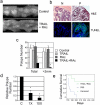Chemoprevention of colorectal cancer by targeting APC-deficient cells for apoptosis
- PMID: 20348907
- PMCID: PMC3425353
- DOI: 10.1038/nature08871
Chemoprevention of colorectal cancer by targeting APC-deficient cells for apoptosis
Abstract
Cancer chemoprevention uses natural, synthetic, or biological substances to reverse, suppress, or prevent either the initial phase of carcinogenesis or the progression of neoplastic cells to cancer. It holds promise for overcoming problems associated with the treatment of late-stage cancers. However, the broad application of chemoprevention is compromised at present by limited effectiveness and potential toxicity. To overcome these challenges, here we developed a new chemoprevention approach that specifically targets premalignant tumour cells for apoptosis. We show that a deficiency in the adenomatous polyposis coli (APC) gene and subsequent activation of beta-catenin lead to the repression of cellular caspase-8 inhibitor c-FLIP (also known as CFLAR) expression through activation of c-Myc, and that all-trans-retinyl acetate (RAc) independently upregulates tumour necrosis factor-related apoptosis-inducing ligand (TRAIL) death receptors and suppresses decoy receptors. Thus, the combination of TRAIL and RAc induces apoptosis in APC-deficient premalignant cells without affecting normal cells in vitro. In addition, we show that short-term and non-continuous TRAIL and RAc treatment induce apoptosis specifically in intestinal polyps, strongly inhibit tumour growth, and prolong survival in multiple intestinal neoplasms C57BL/6J-Apc(Min)/J (Apc(Min)) mice. With our approach, we further demonstrate that TRAIL and RAc induce significant cell death in human colon polyps, providing a potentially selective approach for colorectal cancer chemoprevention by targeting APC-deficient cells for apoptosis.
Figures




Comment in
-
Synthetic lethal interaction may be a new approach in chemoprevention of colorectal cancer.Gastroenterol Clin Biol. 2010 Oct;34(10):511-2. doi: 10.1016/j.gcb.2010.07.004. Epub 2010 Aug 26. Gastroenterol Clin Biol. 2010. PMID: 20800399 No abstract available.
-
Colorectal cancer chemoprevention: the potential of a selective approach.Expert Rev Anticancer Ther. 2010 Oct;10(10):1559-62. doi: 10.1586/era.10.139. Expert Rev Anticancer Ther. 2010. PMID: 20942626
Similar articles
-
[In situ analyses of molecular mechanisms of colorectal carcinogenesis].Pathologe. 2013 Nov;34 Suppl 2:269-73. doi: 10.1007/s00292-013-1821-y. Pathologe. 2013. PMID: 24196627 Review. German.
-
Suppression of intestinal polyps in Msh2-deficient and non-Msh2-deficient multiple intestinal neoplasia mice by a specific cyclooxygenase-2 inhibitor and by a dual cyclooxygenase-1/2 inhibitor.Cancer Res. 2001 Aug 15;61(16):6131-6. Cancer Res. 2001. PMID: 11507063
-
Chemoprevention of intestinal tumorigenesis in APCmin/+ mice by silibinin.Cancer Res. 2010 Mar 15;70(6):2368-78. doi: 10.1158/0008-5472.CAN-09-3249. Epub 2010 Mar 9. Cancer Res. 2010. PMID: 20215518 Free PMC article.
-
Dietary feeding of grape seed extract prevents intestinal tumorigenesis in APCmin/+ mice.Neoplasia. 2010 Jan;12(1):95-102. doi: 10.1593/neo.91718. Neoplasia. 2010. PMID: 20072658 Free PMC article.
-
Down-regulation of intracellular anti-apoptotic proteins, particularly c-FLIP by therapeutic agents; the novel view to overcome resistance to TRAIL.J Cell Physiol. 2018 Oct;233(10):6470-6485. doi: 10.1002/jcp.26585. Epub 2018 May 9. J Cell Physiol. 2018. PMID: 29741767 Review.
Cited by
-
Chemoprevention of hereditary colon cancers: time for new strategies.Nat Rev Gastroenterol Hepatol. 2016 Jun;13(6):352-61. doi: 10.1038/nrgastro.2016.56. Epub 2016 Apr 20. Nat Rev Gastroenterol Hepatol. 2016. PMID: 27095653 Review.
-
Chemoprevention by nonsteroidal anti-inflammatory drugs eliminates oncogenic intestinal stem cells via SMAC-dependent apoptosis.Proc Natl Acad Sci U S A. 2010 Nov 16;107(46):20027-32. doi: 10.1073/pnas.1010430107. Epub 2010 Nov 1. Proc Natl Acad Sci U S A. 2010. PMID: 21041628 Free PMC article.
-
Periplocymarin Induced Colorectal Cancer Cells Apoptosis Via Impairing PI3K/AKT Pathway.Front Oncol. 2021 Nov 25;11:753598. doi: 10.3389/fonc.2021.753598. eCollection 2021. Front Oncol. 2021. PMID: 34900704 Free PMC article.
-
The roles of retinoic acid and retinoic acid receptors in inducing epigenetic changes.Subcell Biochem. 2014;70:129-49. doi: 10.1007/978-94-017-9050-5_7. Subcell Biochem. 2014. PMID: 24962884 Free PMC article. Review.
-
Design of "smart" probes for optical imaging of apoptosis.Am J Nucl Med Mol Imaging. 2011 Aug 1;1(1):3-17. Epub 2011 Jun 22. Am J Nucl Med Mol Imaging. 2011. PMID: 22514789 Free PMC article.
References
-
- Sporn MB, Dunlop NM, Newton DL, Smith JM. Prevention of chemical carcinogenesis by vitamin A and its synthetic analogs (retinoids). Fed Proc. 1976;35(6):1332–1338. - PubMed
-
- Pitti RM, et al. Induction of apoptosis by Apo-2 ligand, a new member of the tumor necrosis factor cytokine family. J Biol Chem. 1996;271(22):12687–12690. - PubMed
-
- Wiley SR, et al. Identification and characterization of a new member of the TNF family that induces apoptosis. Immunity. 1995;3(6):673–682. - PubMed
-
- Koschny R, Walczak H, Ganten TM. The promise of TRAIL-potential and risks of a novel anticancer therapy. J Mol Med. 2007;85(9):923–935. - PubMed
-
- Ashkenazi A. Directing cancer cells to self-destruct with pro-apoptotic receptor agonists. Nat Rev Drug Discov. 2008;7(12):1001–1012. - PubMed
Publication types
MeSH terms
Substances
Grants and funding
LinkOut - more resources
Full Text Sources
Other Literature Sources
Medical
Molecular Biology Databases
Miscellaneous

